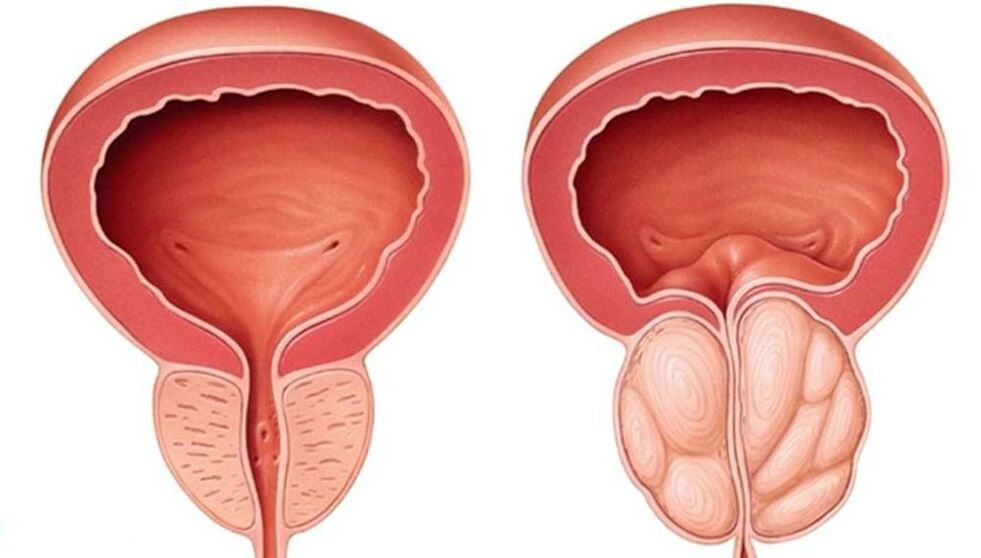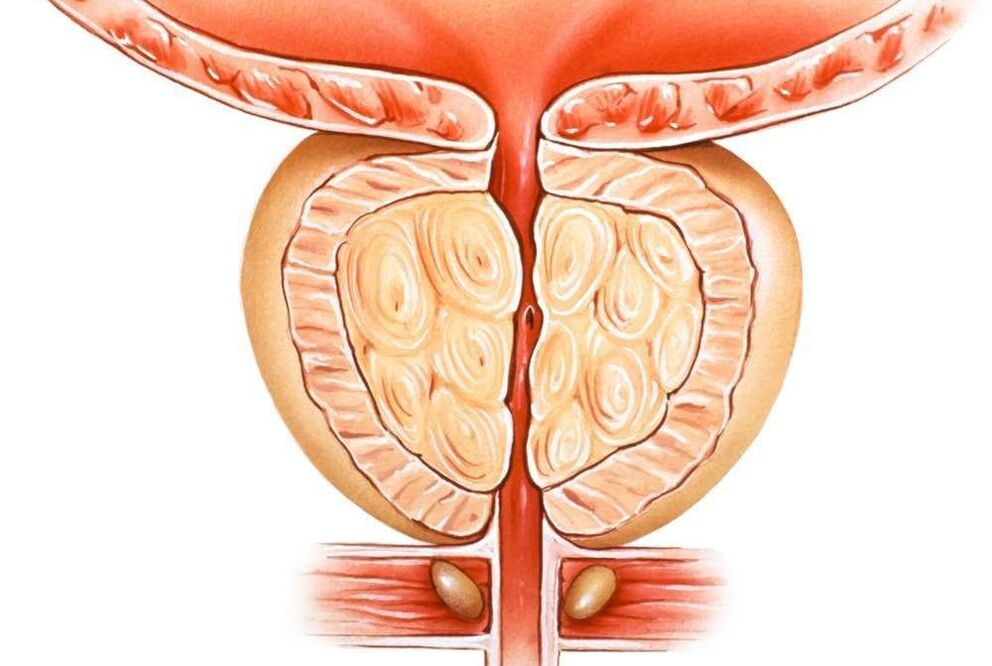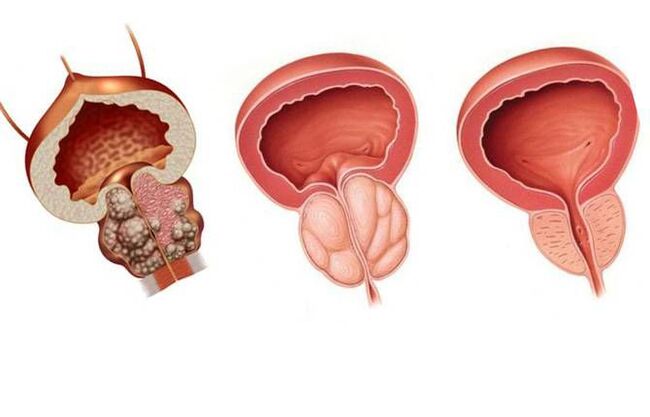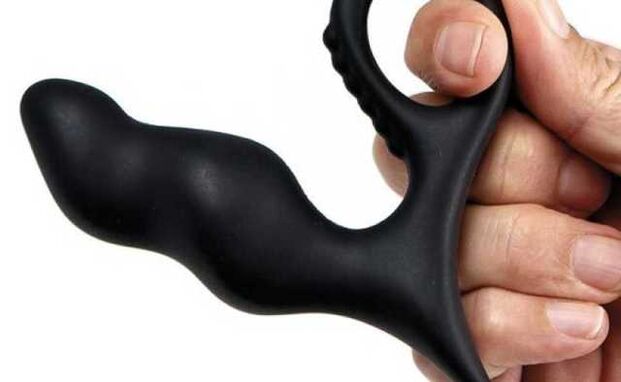Prostatitis is inflammation of the prostate caused by various infections. It is usually performed in an acute form and is accompanied by elevated temperature up to 37-38⁰ C, perineal pain, and urination problems.

Untreated acute prostatitis becomes chronic, which is the most common condition. In this case, symptoms are less pronounced (pain in the lower abdomen, when urinating, sexual dysfunction, general weakness of the body) or are not present at all. However, the consequences can be very serious. The inflammatory process is directly related to the problem of potency, manifested as decreased libido and loss of orgasm.
A neglected infection greatly increases the chance of complications. Especially these diseases, such as:
- pyelonephritis;
- Cystitis;
- Prostate abscess;
- benign prostatic hyperplasia;
- Infertility.
If you seek medical attention in time, such consequences can be avoided. Take care of your health now - in return you will receive excellent health, psychological comfort and improved self-esteem, as well as the quality of your sexual relationship.
Causes of Prostatitis
This question is important, not only because many men face it, but because most don't understand where they got it.
Causes of prostatitis in men:
- Sexually Transmitted Infections.
- Inflammatory diseases of the urethra caused by opportunistic bacterial flora.
- Sexual arrhythmia is an irregular, unbalanced sex life.
- Lack of exercise is a sedentary lifestyle.
- Urolithiasis.
- There are chronic infection foci in the body (chronic tonsillitis, pharyngitis, sinusitis, proctitis and pararectitis, etc. ).
- Abuse of alcohol and spicy food.
- constipate.
- low temperature.
- Pathology of the lumbosacral spine and spinal cord - due to violation of the innervation and nutrition of the prostate.
Why do STIs cause prostatitis? The pathogens of genital infections, especially Neisseria gonorrhoeae, Trichomonas, Chlamydia, Ureaplasma urealyticum, and Mycoplasma, initially affect the male urethra, causing venereal urethritis. But, like any living microorganism, these infections actively multiply under conditions favorable to them, namely the mucous membranes of the urethra and prostate duct.
Of course, if the patient goes to the urology or STD department in time, through the STD test, it is found that there is a sexual infection and it is cured, then there is no reason to have prostatitis. Everything will come to an end with the recovery of the pre-urethritis phase. But with the advanced forms of the disease, and the formal treatments for STDs, when they try to cure them by taking broad-spectrum antibiotic tablets and there is no cure, the microbes can penetrate the posterior urethra and prostate, causing inflammation, the prostateinflammation, and more commonly primary chronic. In this case, it is easy to avoid the development of prostatitis and it is entirely up to the patient.
All you need is:
- Seek immediate medical attention at signs of urinary tract discomfort
- Pass a urologist-recommended STI test
- Comprehensive treatment for identified sexually transmitted infections
- Controlled tests after treatment to determine the presence of STD infections, not only in the urethra but also in prostate secretions
- It is best to have medical prophylaxis in a clinic after casual sex or even before STD symptoms appear and to protect yourself and your loved ones from STDs in general, especially as a cause of prostatitis
symptoms of prostatitis
Since the symptoms of prostatitis are very similar to many diseases of the genitourinary system and even other organs, how can ordinary people recognize or suspect prostatitis? How does prostatitis manifest? What are the first signs of it and how they manifest as the disease progresses. We will discuss this issue in this article.
What other diseases can be confused with prostatitis:
- A sexually transmitted infection (STD) is the most common condition where a man sees a STD after a casual relationship thinking he has an STI. In fact, the prostate is inflamed.
- Urolithiasis produces similar symptoms, but at the same time, it itself triggers an inflammatory process in the prostate.
- Cystitis is rare in men, but the symptoms are very similar to prostatitis.
- Pyelonephritis - Inflammation of the renal pelvis shares some symptoms with inflammation of the prostate gland.
- Scrotal disorders (epididymitis, orchitis, varicocele) - Scrotal heaviness and pain may be associated with these disorders, including prostatitis.
- Diabetes - The patient notices increased urination, as in prostate disease, but there is no slow flow, normal or even increased urine output.
- Other prostate diseases: Prostate cancer and adenomas (benign growths).
- Urethritis.
- Rectal disorders - fissures, hemorrhoids, tumors.
- Lumbar sacral disease.
To make a correct diagnosis, a urologist not only needs to have a good understanding of the symptoms of prostatitis, but also needs to be able to properly perform tests and other diagnostic studies, as well as be able to adequately evaluate their results.
Therefore, consider the signs or symptoms of prostatitis:
Group 1 is pain syndromes. That is, pain in the perineum, groin, lower abdomen, scrotum, penis, rectum, sacrum, coccyx, inner thigh. It may just be a pain, pulling, pressing sensation, or a sharp, throbbing, sharp pain. Sometimes a man simply complains of some discomfort in these areas, either during or outside of urination. Often, the pain is exacerbated by prolonged sitting in a chair or car.
In chronic flaccid prostatitis, pain may decrease after intercourse. Pain during ejaculation may be felt if inflammation is strongly expressed in the prostate or if large calcifications (stones) form in the gland.
Group 2 Symptoms - Urinary Disorders. Increased urination, first at night and then throughout the day. The flow of urine becomes sluggish, the volume of the parts decreases, the transparency of the urine decreases, and blood may appear. With severe swelling of the prostate or fibrosis of the glands around the urethra, there is marked difficulty in emptying the bladder. Men have to push hard and wait a while to urinate.
Group 3 - Aggressive functions. In the early stage of prostatitis, increased libido, excessive excitement, and premature ejaculation. In addition, due to decreased production of sex hormones, libido decreases and erections decrease. A man is either unable to engage in sexual intercourse or has started and cannot finish it. However, even when ejaculation occurs, the orgasm is sluggish or barely felt. If erection or ejaculation is accompanied by pain, the man himself refuses new contact, adversely affecting his future sexual function due to prolonged abstinence. This also leads to the progression of congestive prostatitis. A vicious circle emerges.
Group 4 - These are general symptoms. Elevated body temperature, fatigue, weakness, irritability may occur, which are associated with the presence of inflammatory processes and hormonal imbalances and failure of sexual life. Some patients experience hyperhidrosis (excessive sweating) in the groin area and redness of the glans.
Due to a sufficiently pronounced inflammatory process in the prostate of the urethra, mucus or purulent discharge may occur.
The clinical presentation of each patient with prostatitis is different. Not all symptom groups are necessarily present, and not all symptoms may be apparent. With the chronic course of the prostate, disappearing clinics and mild symptoms are observed, but this does not mean that it is the least harmful to men's health.
Therefore, if you notice any of the above-mentioned manifestations of prostatitis, make an urgent urologist appointment. Do not delay contacting your doctor, because even if the discomfort has passed, it does not mean that the inflammatory process has stopped. It just goes into a latent period that will gradually damage your health and destroy the prostate.
The best option is a preventive examination every six months by a urologist, including diagnostic palpation of the prostate, microscopy of its secretions, ultrasonography, and a PSA blood test. So you can not only protect yourself from the negative effects of advanced chronic prostatitis, adenoma and prostate cancer.
treat prostatitis
Modern methods of treating prostatitis include the following:
- Medication (prescription of antiviral and antifungal drugs);
- maintenance therapy (prescription of immune-stimulating drugs, taking food supplements);
- Urology massage (prostate massage);
- LOD therapy (a method of restoring potency using low pressure);
- A set of special physical exercises for relaxation;
- Physician advice on nutrition, lifestyle, sexual relationships.
In treatment, I use the best methods of leading medical centers and my own development with great results.
Congestive (congestive) prostatitis

Treatment of congestive prostatitis presents certain difficulties because the cause of this inflammation of the prostate is the person's lifestyle and sexual activity. Therefore, only the patient himself, not the doctor, can directly influence these processes. But even in such difficult situations, it can help patients. For the treatment of congestive or congestive prostatitis, a special combination therapy has been developed that eliminates the effects of blood stasis in the venous plexus of the prostate and the secretion of the prostate in its ducts and acinars.
Treatment of congestive prostatitis
After an initial diagnosis, which includes:
- Microscopy, sexually transmitted infection, cultured prostate secretion analysis
- blood test for PSA
- General urine and blood tests
- blood chemistry
- Ultrasound of the prostate, its venous plexus
- kidney ultrasound
Establish the diagnosis of chronic congestive prostatitis, determine the complexity of drug therapy and necessary procedures, including:
- Prostate massage through the rectum is necessary to remove leukocyte plugs, mucus, and congestive inflammatory secretions of the prostate in the ducts. It is the main treatment procedure and also improves blood flow to the prostate, which is a factor in fighting blood stasis.
Massage is performed by a urologist. Session durations range from 30 seconds to 2 minutes. From 10 per course. The fee is 600 rubles.
Even if the patient does not have the opportunity to complete the full course of congestive prostatitis, he must participate in at least 10 massages. Taking the drug alone will not have the desired effect in treating prostate congestion.
- Vibration massage of the prostate is a very good and effective way to treat congestive prostatitis. With the help of special devices that generate vibrations, heat and magnetic fields, the blood supply to the glands improves and the adhesion of the leukocyte plug to the wall of the prostate duct weakens, which helps to remove it during subsequent finger massages. It is usually done before the massage.
- Magnetic laser therapy improves blood flow and nutrition to the glands, removes inflammatory products from them, and relieves swelling. Many patients feel its effects on the first day of treatment, manifested by reduced pain and tightness in the prostate area.
This method of treating congestive prostatitis has long been established and has been used successfully for many years, constantly updated to include new modern methods and methods. Chronic congestive prostatitis can and should be treated to achieve long-term remission and significantly improve the quality of life of the modern man.
BPH

Prostate adenoma, or what is now commonly known as benign prostatic hyperplasia (BPH), is a chronic disease that occurs mostly in older men, at least 50 years later. After 70 years, more than 50 percent of men already have complications from the disease. Although there are cases of its earlier development.
Prostate adenomas are accompanied by growth of their glandular and stromal (connective) tissue. As a result, nodules form in the thickness of the glands, and as they reach their larger size, they begin to compress the surrounding tissues - the bladder, urethra, rectum, and sometimes ureters, disrupting the normal function of these organs.
Causes of prostate adenoma
The development of prostate adenomas is associated with hormonal imbalance in older men, a manifestation of "andropause". Over the years, testosterone, the main male hormone produced by the testes, decreases while the female hormone estradiol increases (especially in men with high body fat). Direct negative effects of female hormones on the prostate have been demonstrated, as well as increased production of dihydrotestosterone in prostate cells, leading to active growth of its tissue and the development of benign prostatic hyperplasia (i. e. , adenoma).
Reasons for the development and progression of BPH also include:
- Lack of motivation - a sedentary lifestyle
- alcoholism and smoking
- Foods high in fat, cholesterol, spicy, spicy
- low sexual activity
In principle, chronic prostatitis is not the cause of prostate adenomas, but in the course of simultaneous occurrence, it can lead to more pronounced symptoms and a rapid development of the complications of BPH.
Symptoms of Prostate Adenoma
Symptoms of prostate adenoma depend on the stage of the disease, decompensation, the development of complications, and the direction of tumor growth.
- First, there are signs of difficulty urinating, a slow flow of urine that lasts 15-20 times a day, and nocturia - nocturnal urination.
- Then, as the muscles of the bladder weaken, worry about the pain in the lower abdomen, feel that the bladder is not emptying completely, and the urine comes out in batches, drop by drop, you have to strain the abdominal muscles. It ends with the complete loss of the detrusor muscle - the bladder muscle that excretes urine.
- When combined with chronic prostatitis, pain in the perineum and rectum, fever, and mucus and pus discharge from the urethra.
- Urine is discolored, cloudy, and blood droplets may appear.
- Impaired sexual function.
- As the prostate adenoma grows toward the trigone formed by the ureteral orifice and urethra, ureteral obstruction and obstruction of the flow of urine from the kidneys occur, eventually progressing to chronic renal failure and urolithiasis at a faster rate.
Major complications of prostate adenoma:
- Acute Urinary Retention - Urgent bladder catheterization is required.
- Urolithiasis and inflammation of the kidneys (pyelonephritis), bladder (cystitis), and urethra occur due to stagnant urine.
- Blood appears in the urine.
Chronic renal failure is a serious complication that can lead to death.
Treatment of prostate adenoma
The clinic treats prostate adenomas without surgery, i. e. drug therapy, which is most effective for stage 1 and sometimes stage 2 benign prostatic hyperplasia.
Surgical treatment of prostate adenomas is performed through decompensation, with numerous prostate adenomas growing toward the bladder triangle. It has different types:
- Beginning with an open transvesical adenomatectomy - removal of the tumor through the bladder
- Ending with a minimally invasive approach, the adenoma tissue in the urethra or the hyperplastic area of the prostate is completely removed when it is passed through the urethra with the help of electrosurgical, radio waves and laser technology.
To avoid immediate prostate adenoma surgery at the first visit to the urologist, it is necessary to have annual prostate exams, ultrasounds, and PSA blood tests.
prostate massage
One of the most common and very effective therapeutic and diagnostic procedures in urology and venereology is prostate massage (prostate). This maneuver has long been used by urologists and is familiar to nearly all patients with prostate, seminal vesicle, and sexually transmitted infections.
Why use prostate massage?
Prostate massage can be used in two situations:
For diagnostic purposes:
- Obtaining prostate secretions for microscopic analysis
- Determination of the presence of sexually transmitted infections (Chlamydia, Ureaplasma, Mycoplasma, Gonorrhea, etc. ) in the prostate by PCR, PIF, and other methods
- Culture material for determination of microflora and antibiotic susceptibility
- Obtain subjective data on pain, density, gland size - so-called diagnostic palpation of the prostate
For therapeutic purposes:
- Release ducts from leukocyte plugs and mucus
- Improves blood circulation to the prostate, allowing better penetration of drugs into its tissues and decongestion
When is prostate massage prescribed?
Prostate massage is suitable for a variety of men's health issues such as:
- Chronic bacterial and nonbacterial prostatitis
- Chronic seminal vesiculitis - massage the prostate and seminal vesicles
- chronic and delayed urethritis
- Prostatitis due to genital infection
- Erectile Dysfunction and Infertility Associated with Prostate Disease
- Have preventive purposes in the final stages of STD treatment
Prostate massage is not performed in the presence of acute suppurative inflammation of the reproductive organs!
How to perform a prostate massage?
There are several classic prostate massage poses.
The most common is the knee-elbow position, when the patient stands on the sofa with both knees, the arms are bent at the elbow joints, and the waist is bent.
In the case of spinal disease, old age, and excess weight, the leg can be placed on the left side of the bent knee, on the stomach.
When massaging the seminal vesicles, the patient stood with his feet on the sofa, with his back to the doctor, in a semi-squatting position.
During prostate massage, the urologist inserts his index finger into the patient's rectum and begins to alternately massage the left and right lobes of the prostate until the interlobar sulcus (isthmus). During this procedure, which lasts 30 seconds to 2 minutes, the doctor receives information about the gland's pain, size, consistency, surface, severity of wrinkles, and can access the secrets of the prostate for analysis.
During prostate massage, there may be some discomfort, urgency, pressure in the lower abdomen and penis. With severe pain, the massage stopped.
It is very important that this procedure is performed by a qualified experienced urologist or venereal physician so as not to harm the man, nor the prostate
Prostate Vibration Massage

Vibration Massage for the Prostate - Uses vibrations, magnetic fields and heat to treat chronic prostatitis. This type of physical therapy improves blood flow and nutrition to the prostate tissue. Vibration massage helps to remove leukocyte plugs in glandular ducts. Suffering from calculous prostatitis - one of the alternatives to finger massage. Meeting duration is 10 to 20 minutes.
Prevent prostatitis
Preventing prostatitis includes avoiding triggers that cause prostatitis, as well as:
- Try not to freeze for a long time, and pay attention to proper clothing if you will be in the refrigerator or on the street for a long time.
- For constipation, use laxatives and don't torture yourself.
- If you have a sedentary job, give yourself a "fitness break" every hour (or at least get up and walk around).
- Try to have regular sex life, because this is completely in line with a person's normal lifestyle and can avoid many problems, not just prostatitis.
- Try to eat regularly, maintain an active lifestyle, don't get sick, and finally, think about your health from time to time.
And don't forget to visit your urologist regularly.























